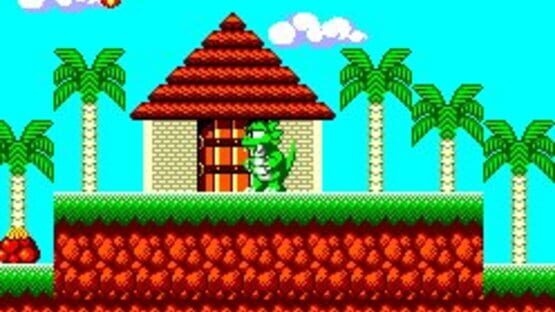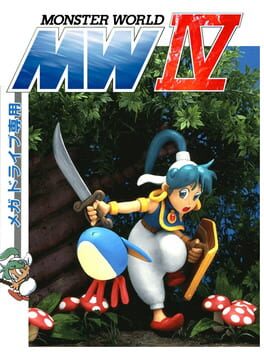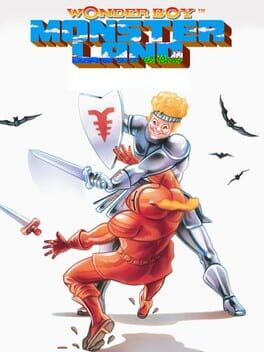

A direct sequel to Wonder Boy in Monster Land, you wander through the lands using multiple forms that each have different abilities. Each defeated boss unlocks a new form that has to be used to advance to a new area, while shops give you access to new equipment for money.
Also in series
Reviews View More
It's ironic this is considered the de-facto Master System game - and it is! It's an iconic and unique classic, and for some, the pinnacle of the Wonder Boy series.
The problem is it's best played elsewhere. The Charisma system makes this Master System original a drag. It's removed from both the later Game Gear port and the DotEmu remake. Play either of those instead. (no idea how the PC-Engine version handles this)
I would've finished a full run of this but I kept re-doing the same Dragon Mail subquest over and over - first cause I locked my charisma out of purchasing it, and then again because the password I generated to get enough charisma to buy it locked me out of my mouse transformation. I don't have the motivation to give it another go rn, so I think I'm gonna focus on other RPG's for the meantime.
The problem is it's best played elsewhere. The Charisma system makes this Master System original a drag. It's removed from both the later Game Gear port and the DotEmu remake. Play either of those instead. (no idea how the PC-Engine version handles this)
I would've finished a full run of this but I kept re-doing the same Dragon Mail subquest over and over - first cause I locked my charisma out of purchasing it, and then again because the password I generated to get enough charisma to buy it locked me out of my mouse transformation. I don't have the motivation to give it another go rn, so I think I'm gonna focus on other RPG's for the meantime.
Esta es la cuarta entrega de la saga y es conocida en Japón como Monster World II. Es el primer titulo que no ha sido diseñado para las recreativas, sino para la Sega Master System (1989). Mas tarde en 1991, fue porteado a la Sega Game Gear. También es el primer juego en romper con la barra de vida decreciente con el tiempo, lo cual permite por fin una exploración decente. Y es que este juego ya se puede considerar un metroidvania con backtracking en toda regla.
La historia comienza literalmente al final de Wonder Boy in Monster Land, recreando (de manera más simple) el último nivel del juego y la batalla de Wonder Boy (Bock Lee Temjin) contra el Meka Dragón, tras la cual Wonde Boy quedará maldito y se transformará de Hu-Man a Lizard-Man. Tras escapar del castillo acabaremos en un pueblo que servirá de hub principal para ir a otras zonas, muchas de las cuales no son accesibles porque nos falta algún objeto o habilidad de las que iremos consiguiendo al avanzar en la aventura. Según recorramos las zonas, nos encontraremos con otros 5 dragones mas que nos irán maldiciendo según los vayamos derrotando para finalmente conseguir una cruz que rompa nuestra maldición y poder volver a casa. Este juego trata de adaptarse y saber sacarle partido a las nuevas formas que vamos tomando. Por ejemplo, Lizard-Man puede lanzar fuego, Mouse-Man puede andar por ciertas paredes y techos, Piraña-Man puede nadar libremente, Lion-Man asesta golpes muy fuertes y amplios y Hawk-Man puede volar. Llegado cierto punto en la historia, desbloquearemos una sala en el poblado que nos permitirá cambiar a la forma que queramos antes de (re)explorar la siguiente zona que queramos. Como apartado negativo destacaría lo ridículamente difícil que es matar a algunos dragones, tan solo por el hecho se que tienen 100 puntos de vida y cada golpe tuyo les resta 1 o 2 puntos. Además, las mazmorras son en ocasiones “laberintos” completamente lineales llenos de enemigos, pero se le perdona porque el mundo exterior sí que está bien.
Gráficamente la saga vuelve a los 8-bits, pero los años de experiencia se hacen notar con un rendimiento constante a 60fps sin bajones ni parpadeos y sprites coloridos y un pelin más grandes de lo que suele ser habitual para los 8-bits. Aparte han añadido buenas animaciones al protagonista, podremos ver expresiones cuando ataca o que se le ve distinto cuando está mirando a la derecha que cuando está mirando a la izquierda.
No puedo irme sin mencionar el apartado sonoro, ya que este juego usa el chip modulador FM para añadir uno (¿quizá dos?) canal de audio FM a los 4 canales de audio PSG que ya tiene la Master System. Esto añade sonidos bajos a la ya de por sí muy buena música que tiene el juego, y una vez has jugado con ello, no te apetece jugarlo sin el modulador FM. Este chip solo estaba como add-on para la Mark III o incluido en la Master System japonesa, por lo que en teoría las versiones occidentales nunca se han podido escuchar así. Wonder Boy Anniversary Collection hace una pequeña trampa, emulando una Master System japonesa para que podamos escuchar la versión en inglés de este juego, tan bien como lo hacían en Japón. Todo un detalle.
A pesar de que no creo que este en el podio de los metroidvanias de 8-bits, Wonder Boy III the Dragon’s Trap es un hito enorme para la saga y un buen juego.
La historia comienza literalmente al final de Wonder Boy in Monster Land, recreando (de manera más simple) el último nivel del juego y la batalla de Wonder Boy (Bock Lee Temjin) contra el Meka Dragón, tras la cual Wonde Boy quedará maldito y se transformará de Hu-Man a Lizard-Man. Tras escapar del castillo acabaremos en un pueblo que servirá de hub principal para ir a otras zonas, muchas de las cuales no son accesibles porque nos falta algún objeto o habilidad de las que iremos consiguiendo al avanzar en la aventura. Según recorramos las zonas, nos encontraremos con otros 5 dragones mas que nos irán maldiciendo según los vayamos derrotando para finalmente conseguir una cruz que rompa nuestra maldición y poder volver a casa. Este juego trata de adaptarse y saber sacarle partido a las nuevas formas que vamos tomando. Por ejemplo, Lizard-Man puede lanzar fuego, Mouse-Man puede andar por ciertas paredes y techos, Piraña-Man puede nadar libremente, Lion-Man asesta golpes muy fuertes y amplios y Hawk-Man puede volar. Llegado cierto punto en la historia, desbloquearemos una sala en el poblado que nos permitirá cambiar a la forma que queramos antes de (re)explorar la siguiente zona que queramos. Como apartado negativo destacaría lo ridículamente difícil que es matar a algunos dragones, tan solo por el hecho se que tienen 100 puntos de vida y cada golpe tuyo les resta 1 o 2 puntos. Además, las mazmorras son en ocasiones “laberintos” completamente lineales llenos de enemigos, pero se le perdona porque el mundo exterior sí que está bien.
Gráficamente la saga vuelve a los 8-bits, pero los años de experiencia se hacen notar con un rendimiento constante a 60fps sin bajones ni parpadeos y sprites coloridos y un pelin más grandes de lo que suele ser habitual para los 8-bits. Aparte han añadido buenas animaciones al protagonista, podremos ver expresiones cuando ataca o que se le ve distinto cuando está mirando a la derecha que cuando está mirando a la izquierda.
No puedo irme sin mencionar el apartado sonoro, ya que este juego usa el chip modulador FM para añadir uno (¿quizá dos?) canal de audio FM a los 4 canales de audio PSG que ya tiene la Master System. Esto añade sonidos bajos a la ya de por sí muy buena música que tiene el juego, y una vez has jugado con ello, no te apetece jugarlo sin el modulador FM. Este chip solo estaba como add-on para la Mark III o incluido en la Master System japonesa, por lo que en teoría las versiones occidentales nunca se han podido escuchar así. Wonder Boy Anniversary Collection hace una pequeña trampa, emulando una Master System japonesa para que podamos escuchar la versión en inglés de este juego, tan bien como lo hacían en Japón. Todo un detalle.
A pesar de que no creo que este en el podio de los metroidvanias de 8-bits, Wonder Boy III the Dragon’s Trap es un hito enorme para la saga y un buen juego.
The problem with having some of my first Metroidvania experiences be from the 2000's onward, is that I've been spoiled rotten on the amount of QoL that Wonder Boy III paved the way for. Although I respect anybody who enjoys this game (more power to you!), I, uh... didn't click.
Coming back to this one, I've struggled to remain engaged. The premise is interesting enough, being able to acquire items and unique animal transformations, each of which packs their own ability and allows you to explore further areas. The problem for me, was that the areas weren't interesting enough to be explored. You know those old Arcadey games where you've got a sword, and you're just holding right for the most part while swinging your weapon to one-hit kill oncoming threats? Like hack 'n slash games in which attacking takes significantly more precedence over platforming. That's what Wonder Boy's design feels like, these long horizontal flat stretches broken up by dungeons with even more horizontal stretches of enemy onslaughts.
There are some things the game does to try and spice things up, such as underwater areas, and wall climbing, but these things aren't enough to break up what you're gonna be doing for the whole game, which is run and slash. And with the game's basic combat feel, plus the game running at a lower frame rate (it seemed like 30) compared to most games of that time, the gameplay does not feel smooth and satisfying enough to justify trekking through it, especially in the instances where you might get stuck and will have to redo the areas you've already explored just to confirm if you didn't miss something.
I also wasn't a fan of the animal transformations being relegated to specific rooms, and would've rather preferred the option to transform into any animal with the press of a button, or via my menu whenever I wanted. A map could've been great too. As it currently is, I was not able to remember the specific locations of every animal transformation room, and sometimes I wound up in a room that required an animal that I wasn't currently transformed into. So, time to figure out where's the nearest transformation room, I guess! It was inconvenient and time-wasting.
In the future, I'm still interested in checking out the remake of Dragon's Trap, as I loved the art I saw in it, and am hopeful that it'll iron out some of my gripes about the lack of a map and the overly simplistic combat feel. Without those things, Dragon's Trap is a game full of neat ideas with a dull execution, and I wish I could've enjoyed this one a lot more than I did.
Coming back to this one, I've struggled to remain engaged. The premise is interesting enough, being able to acquire items and unique animal transformations, each of which packs their own ability and allows you to explore further areas. The problem for me, was that the areas weren't interesting enough to be explored. You know those old Arcadey games where you've got a sword, and you're just holding right for the most part while swinging your weapon to one-hit kill oncoming threats? Like hack 'n slash games in which attacking takes significantly more precedence over platforming. That's what Wonder Boy's design feels like, these long horizontal flat stretches broken up by dungeons with even more horizontal stretches of enemy onslaughts.
There are some things the game does to try and spice things up, such as underwater areas, and wall climbing, but these things aren't enough to break up what you're gonna be doing for the whole game, which is run and slash. And with the game's basic combat feel, plus the game running at a lower frame rate (it seemed like 30) compared to most games of that time, the gameplay does not feel smooth and satisfying enough to justify trekking through it, especially in the instances where you might get stuck and will have to redo the areas you've already explored just to confirm if you didn't miss something.
I also wasn't a fan of the animal transformations being relegated to specific rooms, and would've rather preferred the option to transform into any animal with the press of a button, or via my menu whenever I wanted. A map could've been great too. As it currently is, I was not able to remember the specific locations of every animal transformation room, and sometimes I wound up in a room that required an animal that I wasn't currently transformed into. So, time to figure out where's the nearest transformation room, I guess! It was inconvenient and time-wasting.
In the future, I'm still interested in checking out the remake of Dragon's Trap, as I loved the art I saw in it, and am hopeful that it'll iron out some of my gripes about the lack of a map and the overly simplistic combat feel. Without those things, Dragon's Trap is a game full of neat ideas with a dull execution, and I wish I could've enjoyed this one a lot more than I did.
We love a game that immediately starts at the end of the last game and then tells you that everything you did in the last game absolutely did not matter at all.
Half a star off because around the last three bosses or so I started to remember that it's a Wonder Boy game
Half a star off because around the last three bosses or so I started to remember that it's a Wonder Boy game




